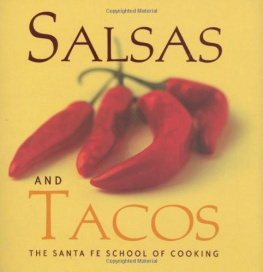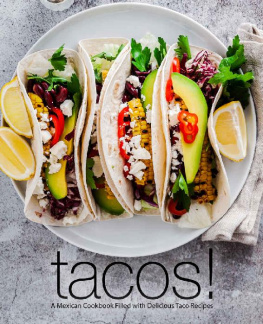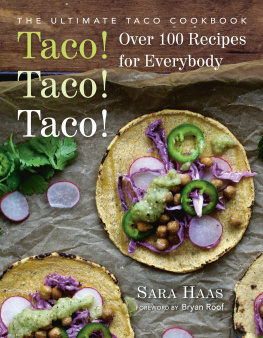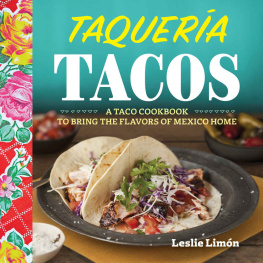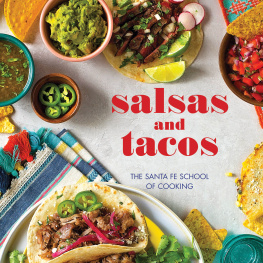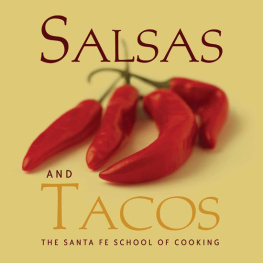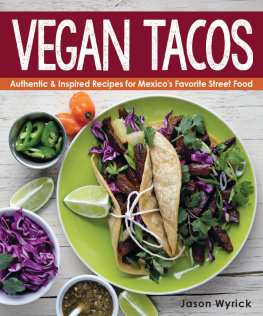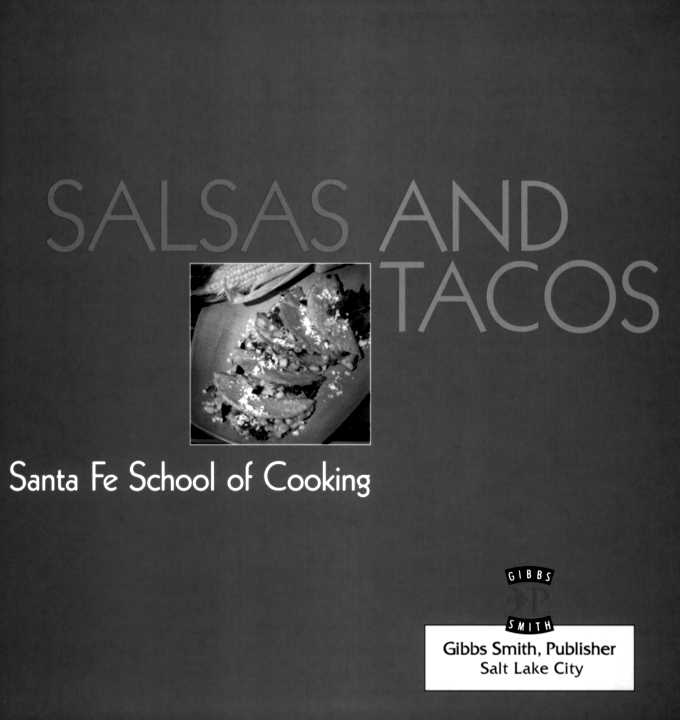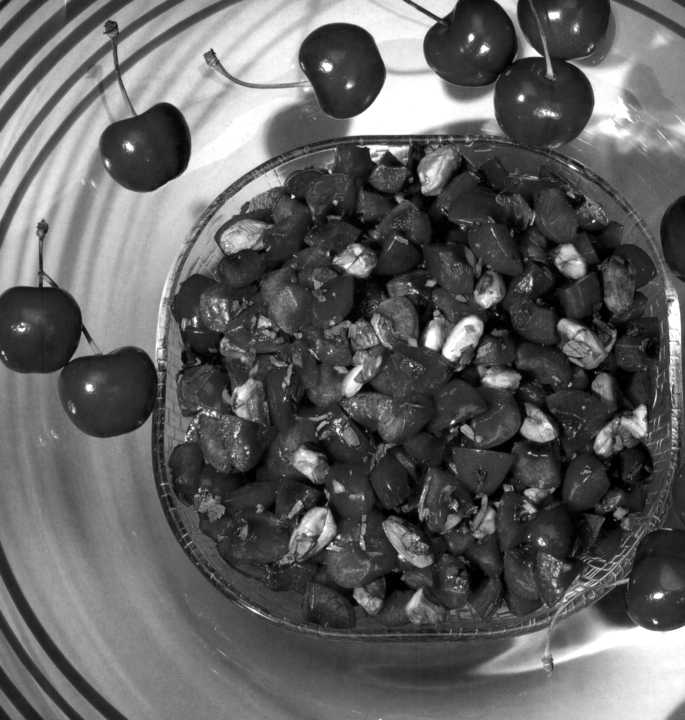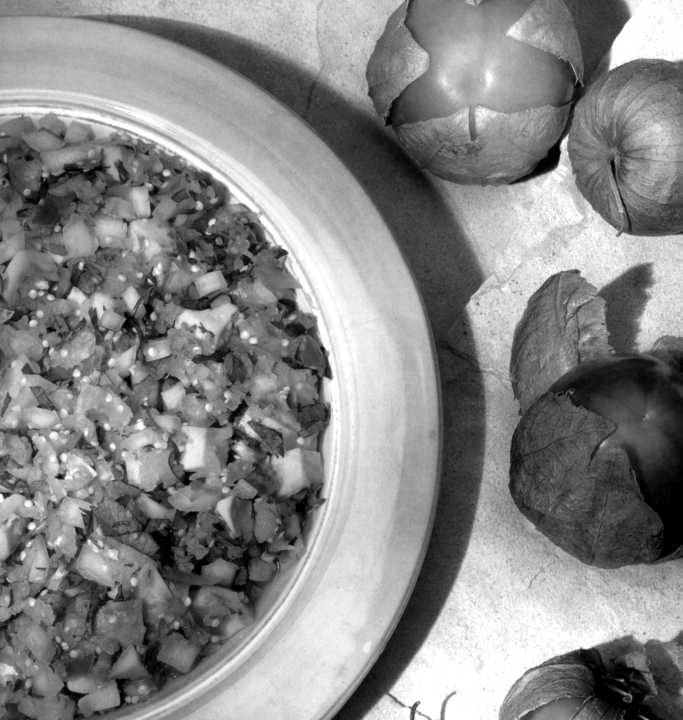SALSAS AND TACOS


This cookbook is dedicated to the friends and guests of the Santa Fe School of Cooking, whose loyal support and patronage helped the school achieve success beyond anyone's wildest dreams.

Avocado - Oval-shaped fruit with a greenish, buttery-tasting flesh. The Hass avocado, with its bumpy brownish-black skin, is the preferred variety for taste. To ripen, leave at room temperature for a day or two, or place in a paper bag to hasten.
Chicos - Corn that has been partially shucked, roasted on the cob, dried, and removed from the cob. The result is a chewy but flavorful kernel requiring a long cooking time.
Cilantro - Fresh plant from the coriander seed; however, it is not interchangeable with the seed. It is a delicate, aromatic herb of the parsley family. To store, recut the stem ends and place in shallow water. Cover with a plastic bag and store in the refrigerator. Readily available in most grocery stores.
Epazote - A pungent herb that grows wild in Mexico and the United States. It is used frequently in seasoning beans and also acts as an anti-flatulent for beans.
Huitlacoche, or cuitlacoche - A silvery-grey to black fungus, commonly known as smut in the United States, that is cultivated in the kernels of corn. The puffy kernels, or lobes, can be detached from the ears and kept refrigerated for several days. It is usually found frozen or canned and is considered a delicacy in Mexico.
Jicama - A tan-skinned tuber. The flavor of the crisp white flesh is compared to that of a water chestnut or a sweet radish. Primarily used uncooked.
Mexican Oregano - A weedyflavored herb reminiscent of, but distinctly different from, the more common Mediterranean oregano. It is used in the dry whole-leaf form vs. the ground form.
Mexican Vanilla Bean - The pod of a tropical orchid vine. It is native to the New World, dating back to the Aztec culture.
New Mexican or Southwestern Pinon Nuts - Similar to imported pine nuts but much richer in flavor and oil. They should be stored in the freezer to preserve freshness.
Nopales - Cactus paddles or the paddle-shaped stems from several varieties of the prickly pear cactus plants. The flavor is somewhat similar to a green bean. They are commonly used in Mexican and southwestern cooking.
Posole - Dried corn that has been boiled in a hydrate-lime solution to remove the husk, resulting in an increase in the nutrient value. Used extensively in the Southwest as a side dish or soup.
Tomatillo - A tart green fruit used frequently in Mexican sauces. In appearance only, it resembles a small green tomato in papery husks. It is a close relative of the cape gooseberry that grows wild in the United States. Fresh tomatillos are available in most grocery stores.
Fresh Chiles and Bell Peppers - Fresh chiles and bell peppers are roasted to intensify their flavor, impart smokiness, and facilitate removing the skin.
Our favorite method is to roast chiles and peppers over a burner using the Santa Fe Grill or over a hot fire on a charcoal grill. Chiles may also be roasted under the broiler of a conventional oven.
Arrange chiles so that they are as close to the heat source as possible and keep watch over them. Using tongs, turn them several times as they begin to blister and darken to ensure even charring of the skin.
When 80 to 90 percent of the skin is blistered or blackened, place chiles in a paper or plastic bag or in a bowl covered with plastic wrap and steam for 10 to 15 minutes. Gently peel the charred skin from the chile; a few bits of remaining skin lend a rustic quality to the chile and are not a problem.
Caution: You may want to wear rubber or plastic gloves to protect your hands from the chile oils that can cause skin irritation. Also, do not
touch your face, eyes or nose when handling chiles until after you have thoroughly washed your hands in soap and water.
Dried Whole Chiles - Arrange the chiles in a layer on a preheated 300- to 325-degree heavy skillet or cast-iron comal. You may also use a baking sheet in a 325-degree oven. Toast the whole chiles, turning several times, until they have softened and begin to darken around the edges (about 2 to 3 minutes). Remove from heat.
When cool, remove the stem, seeds, and seed membranes. Discard these. Then, proceed with chiles as directed in the recipe.
Spices, Herbs, Seeds, and Ground Chile - Dry toasting is a method used to intensify the flavors of dry ingredients. In a dry, mediumhot, heavy skillet or comal, toast the ingredients one at a time, stirring or shaking the pan to prevent burning. When the color has begun to deepen and little wisps of smoke start to form, remove immediately and let cool.
Whole seeds may be ground to powder in a coffee grinder or with a mortar and pestle (called a molcajete in Spanish). Toast only what is needed for a particular recipe as most ingredients do not keep well after the application of heat.
Tomatoes and Tomatillos - To roast tomatoes and tomatillos, arrange them on a Santa Fe Grill, a hot comal, or under a broiler. Turn them several times for even roasting, until most of the skin has been charred. Place in a bowl to save the juices. Carefully remove the charred skins. The tomato and tomatillo flesh may be pureed or chopped for sauces and salsas.

Different chiles vary widely in their flavor, spice and heat. The definition of the English word piquancy is "a spiciness, zest, tang or nip." The Spanish word picante means "sharp, hot and spicy to the taste." Below we provide an estimated piquancy level, or an informal heat gauge, for chiles used in Favorite Salsas and Tacos recipes. But, remember, the cook is the best judge. Taste a bit of the chile you plan to use in a recipe before you add it so that your tongue can measure for itself the interplay of flavor, spice and heat that particular chile provides. Then, add just enough according to your desire.

